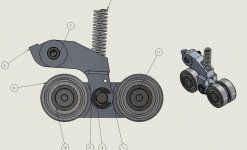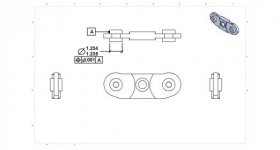olympictool1
Aluminum
- Joined
- Mar 2, 2011
- Location
- NJ
Disclaimer: Self taught GTOL user!
Hey guys I'm drawing a print and i wanted to convey to the guys on the floor (or me so i dont forget when running it) that i need the two posts on each side of this part to be positionally relative to each other. Ive attached a picture of how i currently have the print but im not sure if i have now created a much more complex part then it really is. The posts will all have bearings on them that sit above a convyer belt and assist gravity in holding it flat. So that being said what i am trying to accomplish is to make sure the bearings all touch the conveyor belt more or less. PLease tell me if im on the right track, thank you!........

Hey guys I'm drawing a print and i wanted to convey to the guys on the floor (or me so i dont forget when running it) that i need the two posts on each side of this part to be positionally relative to each other. Ive attached a picture of how i currently have the print but im not sure if i have now created a much more complex part then it really is. The posts will all have bearings on them that sit above a convyer belt and assist gravity in holding it flat. So that being said what i am trying to accomplish is to make sure the bearings all touch the conveyor belt more or less. PLease tell me if im on the right track, thank you!........









